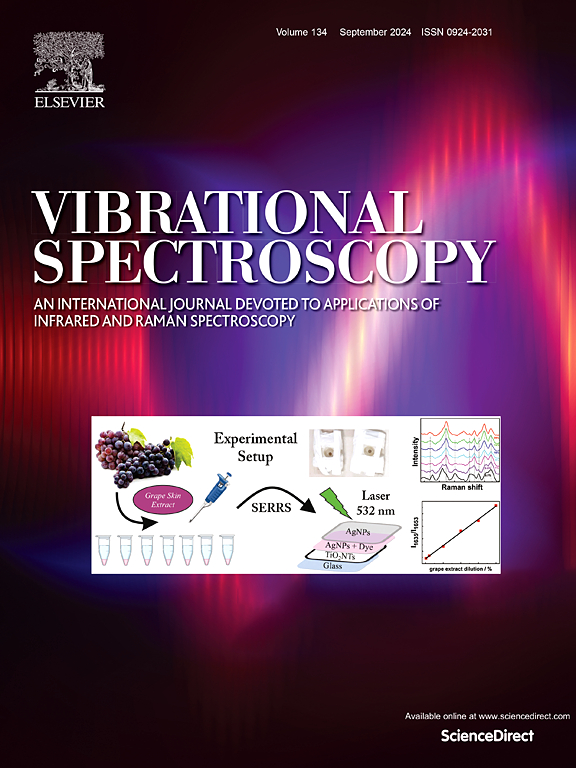Effect of aging on Raman spectroscopy analyses for flexible polyvinyl chloride
IF 3.1
3区 化学
Q2 CHEMISTRY, ANALYTICAL
引用次数: 0
Abstract
For polymers, including flexible polyvinyl chloride, aging processes play a crucial role in determining their long-term performance and function in various applications, especially those exposed to harsh environmental conditions. Aging effects are analyzed using several tools, including Raman spectroscopy, which is an effective tool for detecting molecular and structural changes in the polymer structure, providing a detailed analytical picture of the degradation behavior as a result of aging. The present study investigates the effect of aging on the structural properties of flexible PVC, taking into account the effect of sample thickness on the results of Raman spectroscopy. The results of 2 and 4 mm thick flexible PVC samples produced by extrusion, immediately after production and after one year of production, after being stored at room temperature without being exposed to harsh external conditions were analyzed to study natural aging. The characteristic Raman peaks associated with plasticizer leaching, chain splitting, and oxidation, as well as the SEM images, were analyzed and the obtained results correlated with the sample thickness. Thicker samples showed a lower rate of detectable chemical changes in the polymer structure, attributed to slower oxygen diffusion and lower chlorine release rate compared to thinner samples exposed to the same environmental conditions. Therefore, it is essential to consider the sample thickness factor in Raman spectroscopy analyses, as it greatly affects the sensitivity and interpretation of the results.
老化对柔性聚氯乙烯拉曼光谱分析的影响
对于聚合物,包括柔性聚氯乙烯,老化过程在决定其长期性能和功能的各种应用中起着至关重要的作用,特别是那些暴露在恶劣环境条件下的应用。使用几种工具分析老化效应,包括拉曼光谱,这是检测聚合物结构中分子和结构变化的有效工具,提供了老化导致的降解行为的详细分析图。研究了老化对柔性聚氯乙烯结构性能的影响,并考虑了样品厚度对拉曼光谱结果的影响。对挤出生产的2和4 mm厚柔性PVC样品,在生产后立即和生产一年后,在室温下保存而不暴露于恶劣的外部条件后的结果进行分析,研究自然老化。分析了增塑剂浸出、链裂和氧化相关的特征拉曼峰以及SEM图像,并得出了与样品厚度相关的结果。与暴露在相同环境条件下的较薄样品相比,较厚的样品在聚合物结构中显示出较低的可检测化学变化速率,这归因于较慢的氧气扩散和较低的氯释放速率。因此,在拉曼光谱分析中必须考虑样品厚度因素,因为它极大地影响结果的灵敏度和解释。
本文章由计算机程序翻译,如有差异,请以英文原文为准。
求助全文
约1分钟内获得全文
求助全文
来源期刊

Vibrational Spectroscopy
化学-分析化学
CiteScore
4.70
自引率
4.00%
发文量
103
审稿时长
52 days
期刊介绍:
Vibrational Spectroscopy provides a vehicle for the publication of original research that focuses on vibrational spectroscopy. This covers infrared, near-infrared and Raman spectroscopies and publishes papers dealing with developments in applications, theory, techniques and instrumentation.
The topics covered by the journal include:
Sampling techniques,
Vibrational spectroscopy coupled with separation techniques,
Instrumentation (Fourier transform, conventional and laser based),
Data manipulation,
Spectra-structure correlation and group frequencies.
The application areas covered include:
Analytical chemistry,
Bio-organic and bio-inorganic chemistry,
Organic chemistry,
Inorganic chemistry,
Catalysis,
Environmental science,
Industrial chemistry,
Materials science,
Physical chemistry,
Polymer science,
Process control,
Specialized problem solving.
 求助内容:
求助内容: 应助结果提醒方式:
应助结果提醒方式:


